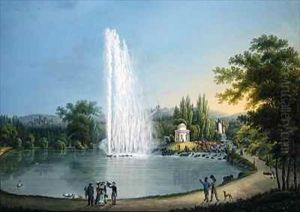Johann Heinrich Bleuler Paintings
Johann Heinrich Bleuler was a Swiss artist born on March 16, 1758, in Feuerthalen, Schaffhausen, Switzerland. He came from a family with artistic background; his father, Johann Ludwig Bleuler, was also a painter. Johann Heinrich is best known for his works in watercolor and for his landscape paintings that depict the Swiss scenery with a careful attention to detail and an emphasis on the picturesque.
Bleuler showed an early interest in art and was trained by his father. He further developed his skills by studying with other artists and was particularly influenced by the landscape painter Johann Heinrich Wüest. Bleuler's career spanned a period that saw a growing appreciation for Swiss landscapes, partly spurred by the rise of tourism in Switzerland and the romantic movement which idealized nature and the countryside.
He took over the family's art and publishing house, 'Bleuler'sche Kunsthandlung', where he produced a large body of work, including engravings, watercolors, and prints. Bleuler's artworks often featured the Swiss Alps, lakes, and traditional Swiss life, capturing the tranquility and grandeur of the landscapes. He was adept at using light and shadow to create depth and atmosphere in his scenes.
Bleuler also played a significant role in promoting Swiss art through his publishing house by producing prints and panoramas of Swiss landscapes that were popular among tourists and collectors. His works contributed to the visual documentation of Swiss landscapes during a time when photography was not yet widely available.
Johann Heinrich Bleuler died on October 25, 1823, in Laufen-Uhwiesen near Schaffhausen. His legacy continued through his children, who also became artists and continued the family tradition. Bleuler's work remains significant for its contribution to Swiss art history and for its influence on later artists who sought to capture the essence of Switzerland's natural beauty.
